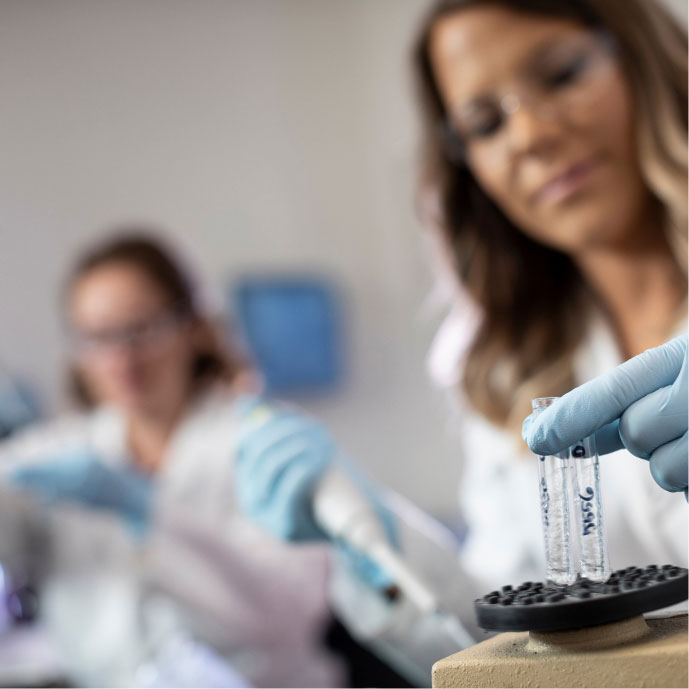Are You a Healthcare Professional?
This European website, initiated and developed by CSL Behring, has two separate sections with the aim to provide information on haemophilia for an international audience, either to European healthcare professionals or to the general public.*
Yes, I am a healthcare professional*
No, I am not a healthcare professional
CURRENT TREATMENT LANDSCAPE
What Treatments Are Currently Available for Haemophilia?
Many patients with haemophilia require regular infusions of coagulation factors.1 While some have come to think that life with prophylactic factor replacement therapy is acceptable, many patients find themselves planning their lives around managing their disease.4
Although newer therapeutic options have become available in recent years, more therapeutic options are needed to further improve clinical outcomes, reduce psychosocial impacts, slow disease progression and decrease morbidity ultimately to improve patient lives.5
CURRENTLY AVAILABLE TREATMENT OPTIONS

Do you know?
TREATMENT DEVELOPMENT
Patients Have Access to a Larger Variety of Treatments and More are in development Today1,2,6
Most haematologists today remember, or are aware of, the limited options available for the treatment of haematology only decades ago. Until the mid-1960s, when Dr. Judith Pool discovered how to isolate the specific clotting factors patients with haemophilia were deficient of, the average life expectancy for a patient with haemophilia was 12 years of age.15
Since that time, treatment for haemophilia has been revolutionised with the currently available primary therapies of factor replacements, non-factor replacements and bypassing agents and novel treatment strategies are still being developed today.2,6
RECENT RESEARCH ADVANCES
STAY UP TO DATE WITH SOME OF THE LATEST RESEARCH

EHL Reduces Annualized Bleeding Rates (ABRs) With Fewer Weekly Doses16
Patients with moderate to severe haemophilia B who received an average of 1,1 doses per week had an ABR of 1,4 with EHL products compared with an ABR of 2,1 after 2,1 doses per week of standard half-life (SHL) products.16
MILESTONES IN HAEMOPHILIA TREATMENT
Prior to the modern era of treatment for haemophilia, no reliable treatments existed. Instead, patients were given whole blood infusions during bleeding episodes. These transfusions did not contain sufficient quantities of clotting factors and as such, were not effective at controlling a bleeding episode. It wasn’t until the mid 1960s when the research and development into haemophilia treatments began to revolutionize patient lives.15
1964
Method for Isolating Clotting Factor VIII Discovered
Dr. Judith Pool discovered that factor VIII, which is damaged in haemophilia A, is the last component of plasma to thaw after freezing. This discovery allowed for clotting factors from multiple donors to be pooled in order to transfuse higher concentrations of clotting factors to patients.18 As a consequence, life expectancy increased from 20 to 24 years of age.13
1960s - 1970s
Development of Stable, Concentrated Formations of Clotting Factors
A method was developed to produce concentrated clotting factors which remained stable as a powder. This allowed patients to store their medication in their refrigerator and administer clotting factors at home.15,19
1970s - 1980s
A Dark Period for Haemophilia: The Blood Supply is Contaminated
Beginning in early 1970s, patients with haemophilia started to become infected with hepatitis after first exposure to factor concentrate transfusions.15,20 In early 1980s, it was established that more than half of Americans living with haemophilia had been infected with human immunodeficient virus (HIV).15,21
1992 - 1999
The First Genetically Engineered Recombinant Factor Product Approved by the EMA and FDA
The European Medicines Agency (EMA) and the United States (US) Food and Drug Administration (FDA) approved the first genetically engineered factor replacement therapies for haemophilia A and B. These engineered products revolutionized care.13,22,23
2014 - 2016
2011 - 2017
Trials of First Gene Therapy Products
In 2011, results of the first phase 1 clinical trial for factor IX gene therapy and in 2017 results from a phase 1/2 trial for factor VIII gene therapy were published.3,28
2022-PRESENT
First Gene Therapies for Haemophilia Approved in Europe and in the USA
In 2022 and 2023, the first adeno-associated virus vector-based gene therapies for the treatment of adults with haemophilia A and B were approved in Europe and in the USA.29-31

Previous
Living with Haemophilia Today
Recent scientific advancements have revolutionized available treatments and more can be done to ensure patients are living the highest quality life.
Next
Gene Therapy
Discover the advances scientists have made over the last 50 years, making genetic therapies possible for many patients with genetic diseases and chronic conditions.
References
- Srivastava A, Santagostino E, Dougall A, et al. WFH guideline for the management of hemophilia, 3rd edition. Haemophilia. 2020;00:1-158.
- Nathwani AC, Reiss UM, Tuddenham EGD, et al. Long-term safety and efficacy of factor IX gene therapy in hemophilia B. N Engl J Med. 2014;371:1994-2004.
- Rangarajan S, Walsh L, Lester W, et al. AAV5-Factor VII gene transfer in severe hemophilia A. N Engl J Med. 2017;377(26):2519-2530.
- Cutter S, Molter D, Dunn S, et al. Impact of mild to severe hemophilia on education and work by US men, women, and caregivers of children with hemophilia B: The Bridging Hemophilia B Experiences, Results and Opportunities into Solutions (B-HERO-S) study. Eur J Haematol. 2017.98:18-24.
- Perrin GQ, Herzog RW, Markusic DM. Update on clinical gene therapy for hemophilia. Blood. 2019;133(5):407-414.
- Mancuso ME, Santagostino E. Outcome of clinical trials with new extended half-life FVIII/IX concentrates. J Clin M ed. 2017;6,39.
- Mancuso ME, Lubetsky A, Pan-Petesch B, Lissitchkov T, Nagao A, Seifert W, Li Y, Santagostino E. Long-term safety and efficacy of rIX-FP prophylaxis with extended dosing intervals up to 21 days in adults/adolescents with hemophilia B. J Thromb Haemost. 2020;18(5):1065-1074.
- US Food and Drug Administration (FDA). FDA approves emicizumab-kxwh for hemophilia A with or without factor VIII inhibitors. FDA approves emicizumab-kxwh for hemophilia A with or without factor VIII inhibitors | FDA. Accessed July 2023.
- European Medicines Agency (EMA). Hemlibra (emcizumab). Hemlibra | European Medicines Agency (europa.eu). Accessed July 2023.
- Callaghan MU, Negrier C, Paz-Priel I, Chang T, Chebon S, Lehle M, Mahlangu J, Young G, Kruse-Jarres R, Mancuso ME, Niggli M, Howard M, Bienz NS, Shima M, Jiménez-Yuste V, Schmitt C, Asikanius E, Levy GG, Pipe SW, Oldenburg J. Long-term outcomes with emicizumab prophylaxis for hemophilia A with or without FVIII inhibitors from the HAVEN 1-4 studies. Blood. 2021 Apr 22;137(16):2231-2242.
- High KA, Roncarolo MG. Gene therapy. N Engl J Med. 2019;381(5):455-464.
- McCain J. The future of gene therapy. Biotechnol Healthc. 2005;2(3):52-54,56-60.
- Hemophilia Federation of America (HFA). Bleeding Disorders Historical Timeline. https://www.hemophiliafed.org/history-of-bleeding-disorders/ Accessed July 14, 2023.
- Anguela XM, High KA. Entering the modern era of gene therapy. Annu Rev Med. 2019;70:273-288.
- National Organization for Rare Disorders (NORD). Rare Disease Database-Hemophilia B. https://rarediseases.org/rare-diseases/hemophilia-b/. Accessed July 14, 2023.
- Chhabra A, Spurden D, Fogarty PF, et al. Real-world outcomes associated with standard half-life and extended half-life factor replacement products for treatment of haemophilia A and B. Blood Coagul Fibrinolysis. 2020;31(3):186-192.
- Ay C, Feistritzer C, Rettl J, et al. Bleeding outcomes and factor utilization after switching to an extended half-life product for prophylaxis in haemophilia A in Austria. Sci Rep. 2021;11(1):12967.
- Pool JG, Hershgold EJ, Pappenhagen AR. High-potency antihaemophilic factor concentrate prepared from cryoglobulin precipitate. Nature. 1964;203:312.
- Morfini M. The history of clotting factor concentrates pharmacokinetics. J Clin Med. 2017;6,35.
- Kasper CK, Kipnis SA. Hepatitis and clotting-factor concentrates. JAMA 1972;221(5):510.
- White GC. Hemophilia: an amazing 35-year journey from the depths of HIV to the threshold of cure. Trans Am Clin Climatol Assoc. 2010;121:61-73; discussion 74-5. PMID: 20697550; PMCID: PMC2917149.
- European Medicines Agency (EMA). BeneFIX. https://www.ema.europa.eu/en/medicines/human/EPAR/benefix. Accessed July 14, 2023.
- European Medicines Agency (EMA). ReFacto AF. https://www.ema.europa.eu/en/medicines/human/EPAR/refacto-af. Accessed July 14, 2023.
- Hemophilia Federation of America (HFA). FDA approves first long-acting rFIX therapy. https://www.hemophilia.org/news/fda-approves-first-long-acting-rfix-therapy. Accessed July 14, 2023.
- European Medicines Agency (EMA). Elocta. https://www.ema.europa.eu/en/medicines/human/EPAR/elocta. Accessed July 14, 2023.
- European Medicines Agency. Idelvion. https://www.ema.europa.eu/en/medicines/human/EPAR/idelvion. Accessed July 2023.
- European Medicines Agency. Alprolix. https://www.ema.europa.eu/en/medicines/human/EPAR/alprolix. Accessed July 2023.
- Nathwani AC, Tuddenham EGD, Rangarajan S, et al. Adenovirus-associated virus vector-mediated gene transfer in hemophilia B. N Engl J Med. 2011;365(25):2357-2365.
- European Medicines Agency (EMA). Roctavian. https://www.ema.europa.eu/en/medicines/human/EPAR/roctavian-0. Accessed July 14, 2023.
- Food and Drug Administration. Approved Cellular and Gene Therapy Products. https://www.fda.gov/vaccines-blood-biologics/cellular-gene-therapy-products/approved-cellular-and-gene-therapy-products. Accessed September 5, 2023.
- European Medicines Agency (EMA). Hemgenix. https://www.ema.europa.eu/en/medicines/human/EPAR/hemgenix. Accessed July 14, 2023.






